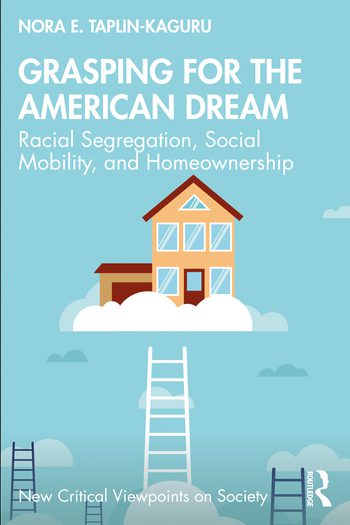
A new book by Earlham College professor Nora Taplin-Kaguru investigates the role that the pursuit of home ownership plays in maintaining a system of racial injustice and segregation in the United States.
Grasping for the American Dream: Racial Segregation, Social mobility, and Homeownership (Routledge, 2021) is based on a research study from 2014 to 2018 in Chicago. The book calls on lawmakers to introduce solutions to address structural racism and provide stronger support for prospective homeowners.
“Working-class African Americans remained committed to homeownership, in part because of the moral status attached to achieving homeownership, despite paying more and getting less,” Taplin-Kaguru said about her book, which was written for undergraduate courses in urban sociology, African American studies and the sociology of race.
“For African American homebuyers, success at the American dream of homeownership is directly related to the long-standing dream of racial equality.”
Taplin-Kaguru recruited 68 Black Chicagoans to participate in the study who were in varying stages of buying a home. She worked with Neighborhood Housing Services of Chicago and the West Cook Home Ownership Center to identify individuals participating in home buyer education classes, as opposed to individuals participating in federal rental subsidy programs where ample research already exists.
“For the aspiring homebuyers in this study, delayed homeownership was a practical problem as their families grew or developed new needs while they waited, but they also experienced this as a personal failing due to the strong cultural expectation in the United States that homeownership is a milestone that middle-class adults must achieve,” she said. “Despite using perfectly reasonable housing search strategies to locate homes in stable or improving racially integrated neighborhoods, the structure of racial segregation limits their agency in housing choices.”
The research study was inspired by the 2010 Census which showed a precipitous drop in Chicago’s Black population since 2000.
“Chicago had lost population overall, but most of that losses were from the Black population,” she said. “That got me interested to learn more about who was leaving the city and why. I wanted to know if they were leaving the region altogether or moving to the suburbs. Both were happening.”

“For African American homebuyers, success at the American dream of homeownership is directly related to the long-standing dream of racial equality.”
— Nora Taplin-Kaguru
The link between homeownership and the pursuit of the American dream coming out of her research was initially surprising, Taplin-Kaguru notes.
“I wasn’t expecting it,” she said. “I learned that it was really motivating people’s decision-making. It motivates people to stay in a system that is discriminatory and predatory really and takes advantage of Black homebuyers, especially working-class Black homebuyers.”
At Earlham, Taplin-Kaguru teaches courses called “Urban Sociology” and “Power and Inequality and Society.” She is currently collaborating with five students on a research project investigating how multiracial households choose where to live. Cristina Ortiz, an expert on multiracial families and the socialization of kids from the University of the Pacific, is also a collaborator on the project.
“Most research on housing decisions focus on monoracial households and individuals,” she said. “This project addresses a gap in the limited research available.”
Students involved in the research are conducting dozens of interviews and collecting data this summer in support of the study. Taplin-Kaguru said the project could lead to an opportunity for students to present at the Critical Mixed Race Studies Conference later this year.
Media contact
Brian Zimmerman
Director of media relations
Email: [email protected]
Phone: 765.983.1256